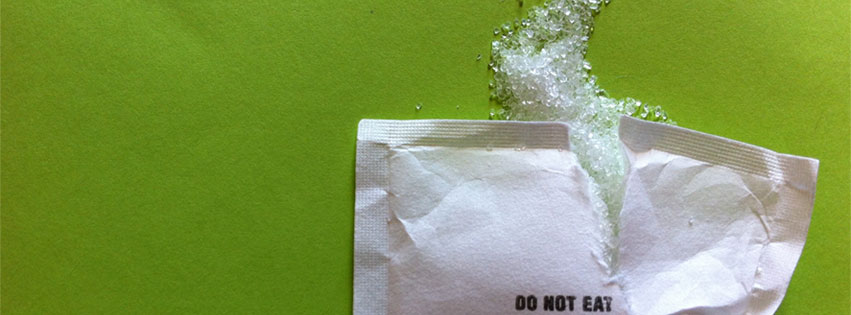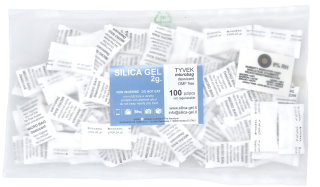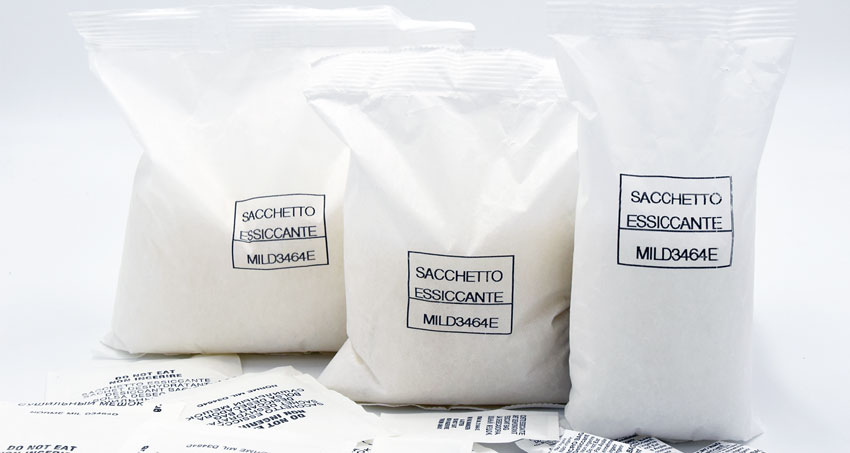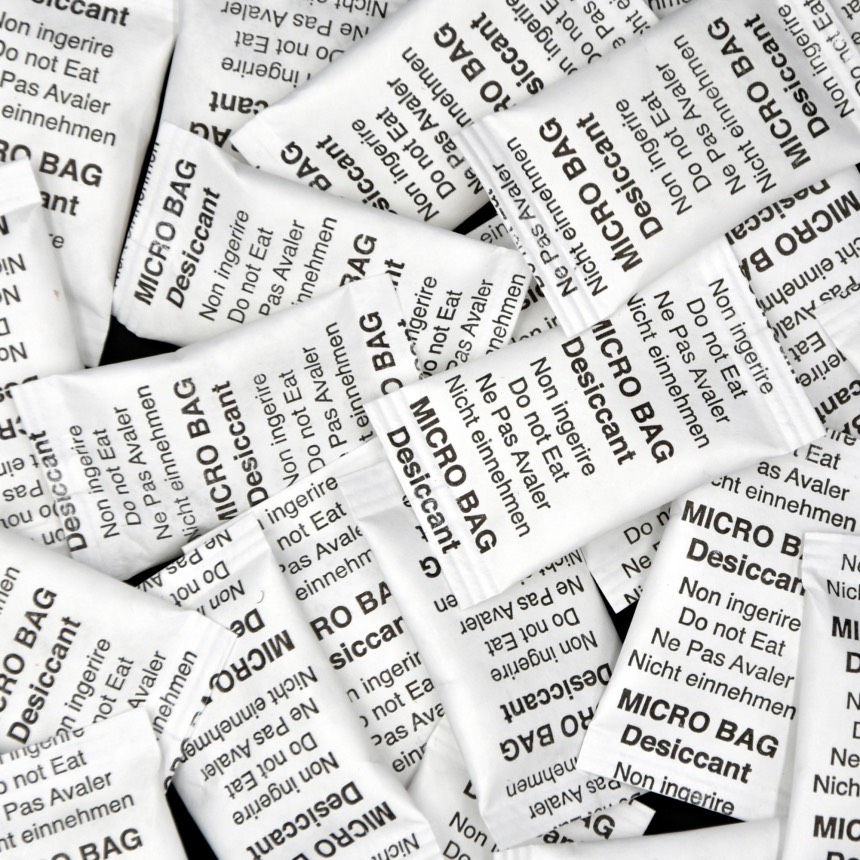Silica Gel: What Is It?
A brief guide to this desiccant.
Silica gel, commonly known as silica gel, is a synthetic desiccant chemically derived from amorphous SiO2 (silicon dioxide). It is non-toxic and has a high capacity for moisture absorption. Silica gel appears as amorphous crystals (granules) or translucent white beads, resembling coarse table salt.
White silica gel has an exceptionally high hygroscopic capacity, primarily due to its crystalline structure, characterized by a significant number of pores. These pores act as receptors for water molecules suspended in the air.
This porosity translates into a larger contact surface, allowing water molecules to interact and bond with the desiccant material.

Where Silica Gel Is Used
Desiccant bags filled with hygroscopic silica gel are used to absorb moisture inside packaging and protect moisture-sensitive products during transportation or storage. Loose silica gel is employed in various industrial, chemical, and museum conservation sectors.
Identifying the applications for desiccant sachets and loose silica gel is complex due to their wide and diverse use in multiple industries. Essentially, silica gel is used wherever reducing relative humidity is necessary to prevent the deterioration of goods, objects, or artifacts. Thanks to its inert and harmless nature, it does not release liquids and presents no handling risks.
Listing all the fields where silica gel is used would require a long list. Below are some of the primary applications:
Protection for Goods, Shipping, and Logistics
Silica gel sachets are essential for preserving all kinds of objects, especially those prone to corrosion (metal objects), mold, or general degradation due to prolonged exposure to high humidity. Desiccant chains are designed for national and international shipping, especially for ocean shipping by boat, to control moisture and condensation inside containers. See the shipping products in the shop >>
Stabilizing Products for Museums and Fine Arts
Silica gel is used to control and stabilize relative humidity inside display cases in museums to preserve objects, artifacts, and historical or artistic items. In this specialized field, silica gel is used in conservation and restoration, archival and library sciences, and the fine arts in general. For such delicate and sensitive applications, the special ProSorb silica gel is used. See museum products in the shop >>
Optical, Electronic, and Electrotechnical Equipment
Silica gel is used to store and protect optical and photographic equipment, such as lenses and camera bodies. It is also used in the packaging of electronic products and within electronic or electromechanical devices, where moisture control is required even during operation.See desiccant products for optics and electronics in the shop >>
Fashion and Natural Materials
Silica gel sachets are used to preserve high-fashion garments, leather goods, and shoes. In addition to protecting the packaged products from mold, they are crucial for preventing oxidation of metal parts like buckles and hooks. See silica gel sachets in the shop >>
Chemical, Pharmaceutical, and Food Industries
Silica gel is used to maintain a stable environment for raw materials, semi-finished, and finished products, protecting them from mold and bacterial growth caused by humidity, both during processing and in packaging. See desiccant sachets in the shop >>
Heavy Industry and Plants
Loose silica gel is essential for protecting machinery and components from corrosion, extending their lifespan. It is used in refineries, power plants, chemical plants, and industrial filters to remove moisture from compressed air and gases, improving efficiency and operational safety. See loose silica gel in the shop >>
Many Uses for One Product
Silica gel is useful in all cases where condensation needs to be reduced, preserving various objects from the humidity in the air. It is particularly effective for paper materials, such as documents, newspapers, books, old photographs, or entire stamp collections, which can deteriorate with prolonged exposure to humidity. Wooden and metal objects, especially in the field of collecting, can also be better preserved using silica gel, protecting heirlooms and delicate items.
Silica gel, whether in sachets or loose, is ideal for protecting electronic components, 3D printer filaments, and in industrial applications.
Additionally, silica gel has many household uses: from drying flowers to absorbing moisture in small spaces such as safes, furniture, or gun lockers.
Safe and Effective Silica Gel
All our products are free from Dimethylfumarate, a fungicidal additive declared toxic.
Since silica gel is highly sensitive to moisture, proper storage is essential. All our hygroscopic salts and desiccant products are sealed in High-Density Polyethylene (HDPE) plastic packaging, which provides almost total impermeability to moisture and isolates the products from premature contact with humidity for several months.

Is Silica Gel Toxic? The Simple Answer Is No.
IAccording to current national and European regulations, silica gel is not toxic and poses no danger to living beings. It is not labeled as a poisonous or irritating substance, nor is it subject to special disposal precautions.
This is true only if the silica gel is a high-quality product, pure, and not contaminated with hazardous or polluting substances.
In 2008, many European states had to take serious measures to prevent the harmful consequences of desiccant bags containing high levels of DMF (Dimethyl fumarate), a highly toxic fungicide found in quantities well above the legal limit in desiccant bags of Chinese origin.
For this reason, it is imperative to ensure the quality of silica gel sachets. This material must always be guaranteed as DMF-free, as this substance is particularly aggressive on the skin, causing respiratory problems in severe cases.
While browsing the web, one may encounter various information about silica gel desiccants, much of which is unfounded and misleading. Putting aside concerns about the suspected toxicity of this material — concerns we hope have been clarified by the above discussion — much of the limited knowledge about silica gel centers around its use.
The Materials of the Sachets:
After discussing the desiccant material itself, it is important to make some clarifications about the packaging that physically encloses it and forms the sachet.
The packaging can be made of two materials: standard (Material A) or dustproof (Material B - Tyvek®).

Humidity Absorbing Sachets in Standard Material A
Material A (standard) is made of paper or non-woven fabric (TNT) and is used in the production of desiccant sachets of various weights, ranging from small sachets of just a few grams to larger ones (up to 1 kg).
It is the most common type of packaging and is used for desiccant sachets (silica gel or bentonite) in various applications.
Material A is inherently very porous, which allows for optimal absorption of relative humidity.
However, through these pores, a very fine silica gel powder can escape due to the friction of the desiccant crystals inside. The release of this powder, which is harmless, is strictly limited by specific European regulations, and the emitted amount is barely visible.

However, through these pores, a very fine silica gel powder can escape due to the friction of the desiccant crystals inside. The release of this powder, which is harmless, is strictly limited by specific European regulations, and the emitted amount is barely visible.
Nevertheless, it may not be ideal when sachets are used in specialized sectors such as electronics, optics, chemical, or pharmaceutical laboratories, and generally where maintaining a sterile environment is necessary. In such cases, it is advisable to consider sachets made from dustproof Material B - Tyvek®.
For all other applications, desiccant sachets made from Material A are an excellent desiccant product, completely safe and highly effective. They are essential for protecting packaging, products, and shipments from humidity. Check out sachets with Material A packaging in the shop >>
Humidity Absorbing Sachets in Dustproof Material B - Tyvek®
For special applications, Material B - Tyvek® is used. This material, similar in appearance to Material A, with a papery feel and translucent look, is certified for producing desiccant sachets with zero dust emission.
The key feature of desiccant sachets with dustproof Material B packaging is their ability to release no trace of dust.
For this reason, it is recommended for use in specific sectors, such as protecting sensitive equipment or instruments where there must be no contamination. Additionally, it is ideal in fields where aesthetics are important, especially with high-end products.
For instance, in high-end fashion products made from leather or fabric, using sachets made from Material B instead of the common Material A can help avoid even the slightest trace of dust. Although minimal and barely visible, such traces may be noticed by more discerning customers. Check out products made from Material B Tyvek® in the shop >>
Dustproof & Food-Grade Material B Sachets
Another type of packaging made from Material B, also dustproof, is food-grade Material B, used in the food and pharmaceutical industries.
The particularity of these sachets is that in addition to emitting no dust, they use certified ink suitable for contact with pharmaceutical or food products.
It is important to note that food-grade sachets can only be used in direct contact with specific products, namely those that do not contain oils or produce any kind of liquid or greasiness.
This is crucial because liquids or oily substances can degrade the quality of the sachet’s packaging, compromising its effectiveness and creating a risk of contamination for the food or pharmaceutical product being protected. Check out food-grade sachets in the shop >>













